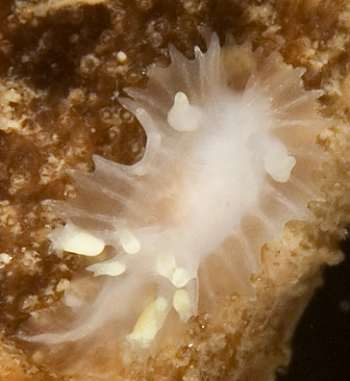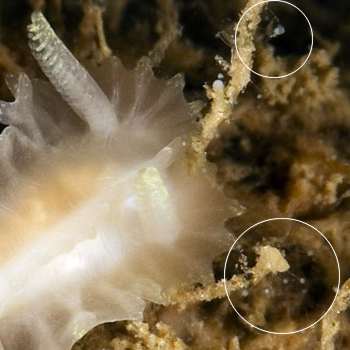
Lophodoris danielsseni
Friele & Hansen, 1876
Order: NUDIBRANCHIA
Suborder: DORIDINA
Superfamily: ANADORIDOIDEA
Family: Goniodorididae
DISTRIBUTION
Known only from western Norway and southern Greenland (Just & Edmunds,1985).
PHOTO
The Trondheim Fjord, Norway. North East Atlantic. Depth: 28 meters. Length: 10 mm. 15. January 2006. Rocky, exposed. Photographer: Kåre Telnes
These small dorids are translucent white with yellow or cream markings. The most distinctive feature of this small dorid is the nature of the mantle skirt, which has been described as umbrella-like (Just & Edmunds,1985) because it is supported by a series long spicules, which radiate out at right angles from the body to the mantle edge like the ribs of an umbrella. The mantle skirt runs around the anterior end of the body, hiding the head, and down each side. In the posterior midline, over the posterior part of the foot, there is a V-shaped gap in the mantle skirt. The tip of each spicule extends out as a short rounded papilla at the edge of the mantle skirt given the edge a scalloped appearance. The posterior-most spicule on each side, flanking the V-shaped gap, is quite swollen. It is cream or yellow in colour as are the tips of the other mantle spicules.
There is a slightly raised ridge down the dorsal midline from between the rhinophores to the gills. This ridge is continued down the midline of the posterior foot. The lamellate rhinophores are slender and tapering, and their tips are cream or yellow. There are up to nine gills, the upper half of which are cream or yellow and quite swollen to closely resemble the posterior pair of mantle papillae. The gills and rhinophores have no pockets into which to contract. The oral tentacles are large rounded, flattened lobes. They can be yellow cream or translucent white.
Little is known of these small animals, which grow to about 10 mm in length. Since their original description, features of their anatomy were described by Odhner (1922), and until Lemche's water colour paintings were published (Just & Edmunds,1985) no colour illustrations were known. Nothing is known of its biology but Lophodoris scala feeds on Entoprocts, which are the food of the related genus Trapania.
-
Friele, H., & Hansen, G. A. 1876. [for 1875]. Bidrag til kundskaben om de norske Nudibranchier. Videnskabs-Selskabet Forhandlinger. Christiania. pp. 69-80, pl. 2.
- Odhner, N. H. 1922. Norwegian opisthobranchiate Mollusca in the collections of the Zoological Museum of Kristiania. Nyt Magazin for Naturvidenskaberne, 60: 1-47. [Meddelelser fra Det Zoologiske Museum, Kristiania, Nr. 1].
- Just, H, & Edmunds, M. 1985. North Atlantic nudibranchs (Mollusca) seen by Henning Lemche, with additional species from the Mediterranean and the north east Pacific. Ophelia Suppl. 2: 1-170.
Rudman, W.B., 2006 (January 17) Lophodoris danielsseni Friele & Hansen, 1876. [In] Sea Slug Forum. Australian Museum, Sydney. Available from http://www.seaslugforum.net/find/lophdani
Related messages
More photos of Lophodoris danielsseni from Norway
January 20, 2010
From: Christian Skauge


Concerning message #15597:
Hello Bill,
happy new year!
I see that the Lophodoris danielsseni is quite rare, and just wanted to share some images with you. I came across two specimens just north of Bergen in Norway over the weekend [2-3 January 2010], and photographed it maybe for the second time ever. It seems I'm only the third photographer to capture this rare nudibranch on camera - incidentally at the exact same spot as Klas Malmberg did.
We both came across this small dorid at 25 meters depth at the house reef of Gulen Dive Resort, a couple hours north of Bergen on the Norwegian west coast. (map link).
The specimen pictured was no more than 7-8 mm long. Another slightly bigger specimen (12 mm) was found just centimeters away.
All the best
Christian Skauge
www.dykkefoto.no
post@dykkefoto.no
Skauge, C., 2010 (Jan 20) More photos of Lophodoris danielsseni from Norway. [Message in] Sea Slug Forum. Australian Museum, Sydney. Available from http://www.seaslugforum.net/find/23126
Dear Christian,
Thanks for some more photos of this interesting and rarely observed species.
I note that in an earlier message I comment about how cold it muxt be at this time of year in your part of the world. I guess at present it is probably warmer in the water than out! - but I still greatly admire your effort.
Best wishes,
Bill Rudman
Re: Lophodoris danielsseni from Norway - first photos
January 19, 2006
From: Claus Nielsen
After posting message #15597, I contacted Prof Nielsen, an expert on entoprocts, for his views on the objects in Kåre's photo. Here is his reply:
Dear Bill,
Many thanks for your mail. There are indeed many entoprocts in the sea and many of them are undescribed! However, I don't think that the creatures circled in the photos are entoprocts. There is no scale, but I think that they are too small, and the description of a spring-like stalk which can retract the head indicates that it is actually a ciliate, something like Vorticella.
Very best wishes. Yours, Claus
Dr Claus Nielsen
Zoological Museum (University of Copenhagen)
DENMARK
Dear Claus,
Thanks for your rapid reply. I guess I shouldn't have used 'spring-like' in my description which does of course does suggest Vorticella, I was really trying to describe the way that stalked entoprocts I have previously tried to draw and photograph always tend to retract - or die. But you are right about the size. The nudibranch is about 10mm long so these little objects are probably too small. That's why I wanted the opinion of an expert in entoprocts.
So Kåre I guess we are back to square one. I still think entoprocts are their most likely food, bt I guess we shouldn't rule out bryozoans. The fact that there are a group of them together staying in one spot means their food is near by - or right there - very tantalising !
Best wishes,
Bill Rudman
Re: Lophodoris danielsseni from Norway - first photos
January 18, 2006
From: Kåre Telnes


Concerning message #15571:
Today, I returned to the same Gorgonian head, and there they where. On the very same branch, two days later! With slightly different optics, I managed to take a few improved pictures. Coming back from the dive, it was encouraging to find your message. This is fun for an amateur like myself.
Locality: The Trondheim Fjord, Norway. North East Atlantic. Depth: 28 meters. Length: 10 mm. 17 January 2006. Photographer: Kåre Telnes
There are both bryozoans (looks like Hornera lichenoides ) and a few ascidians in the neighbourhood, but the slugs did not seem to care much for them. Entoprocts are perhaps too tiny too be noticed with the bare eye? I did not notice any eggs, so I really do not know what they are doing up there, on the coral branch. What do the eggs look like? Other species are spawning at the moment.
Cold? No it is not to bad at the moment, just a few degrees below zero.
Kåre Telnes
kare@seawater.no
Telnes, Kåre, 2006 (Jan 18) Re: Lophodoris danielsseni from Norway - first photos. [Message in] Sea Slug Forum. Australian Museum, Sydney. Available from http://www.seaslugforum.net/find/15597
Dear Kåre,
Thanks for the feedback. One of the problems with entoprocts is that they are so small and inconspicuous. They are also very 'nervous' and at the slightest disturbance their spring-like stalk retracts dragging the zooid down to merge into the background. I have ringed a couple of likely objects in the photo alongside. In the top right there appears to be a single zooid and in the lower ring there appears to be a group of them. I'm afraid they are very difficult to see in the field and they are so sensitive that when you try to collect some to look at under the microscope, they die.
I may be quite wrong, but they look like entoprocts to me. Have a look at the following messages: #3770, #6022, which show species of Trapania feeding on 'carpets' of entoprocts. It is not so easy when they are less abundant.
Your new photos also show the mid-dorsal crest very well. Concerning the egg ribbon. I have no idea what it will look like - you are on the forefront of discovery here. You may be the first person to see its eggs.
Best wishes,
Bill Rudman
Lophodoris danielsseni from Norway - first photos
January 17, 2006
From: Kåre Telnes


Dear Bill,
May I be so bold to propose this new species - Lophodoris danielsseni - for the Sea Slug Forum? Or is it perhaps known under a different name? The identification is done based on a drawing that I found on Jussi Evertsen´s home page.
Locality: The Trondheim Fjord, Norway. North East Atlantic. Depth: 28 meters. Length: 10 mm. 15 January 2006. Rocky, exposed. On gorgonian stalk. Photographer: Kåre Telnes
I have added the species to my own homepage:
Regards
Kåre Telnes
kare@seawater.no
Telnes, K, 2006 (Jan 17) Lophodoris danielsseni from Norway - first photos. [Message in] Sea Slug Forum. Australian Museum, Sydney. Available from http://www.seaslugforum.net/find/15571
Dear Kåre,
You can be as bold as you like when you are sending in interesting photos like this. Yes this is Lophodoris danielsseni. Your photos are almost identical to Henning Lemche's wonderful water colours which were not published until after his death (Just & Edmunds, 1985). The only difference is that in his paintings the tips are a bright yellow rather than the creamy yellow of your animals. The strange creamy yellow swellings on the gills and the similarly shaped and coloured posterior mantle edge papillae, suggest they have evolved for some function. Perhaps they are glandular, or perhaps they mimic something?
Apart from the short video on Jussi Evertsen´s website, I think these are the first photos of this species which have ever been published.
Of particular interest to me is their food. Most goniodorids feed on bryozoans and a few on ascidians, but we now know that one genus, Trapania, specialises on species of the Entoprocta, a phylum previously considered part of the Bryozoa. By chance I have recently seen a review article on the fauna associated with the burrows of Echiuran 'worms' and there is a reference to a Brazilian species which has a host of associated animals, including Lophodoris scala, and two species of Entoprocta, on which the Lophodoris feeds. [check that species for references]. So there is always the possibility that Lophodoris danielsseni also feeds on entoprocts. The little stalked zooids are not the easiest to see, but it would be worth checking out for them if you are lucky enough to find Lophodoris again.
By the way I note you photographed these animals only a few days ago. Correct me if I am wrong but isn't it freezing in your part of the world at the moment.?
- Just, H, & Edmunds, M. 1985. North Atlantic nudibranchs (Mollusca) seen by Henning Lemche, with additional species from the Mediterranean and the north east Pacific. Ophelia Suppl. 2: 1-170.
Best wishes,
Bill Rudman
